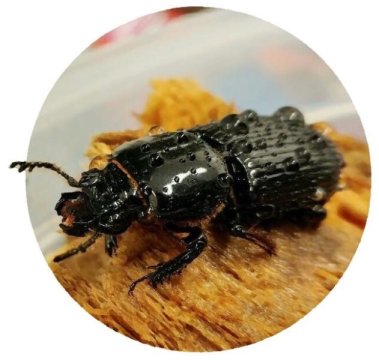[ad_1]
Insects are critical contributors to ecosystem functioning, and like most living organisms their co-evolution with microbes has been essential to support these functions. While many insects are infamous for wreaking havoc wherever they roam, many thousands of species go quietly about their business, providing important services essential to healthy ecosystems using the innovative biochemistry of their microbiomes.
New research from the U.S. Department of Energy Lawrence Berkeley National Laboratory (Berkeley Lab) shows how one such beneficial insect common to the Eastern U.S., the long-horned passalid beetle (Odontotaenius disjunctus), has a hardy digestive tract with microbes to thank for turning its woody diet into energy, food for its young, and nutrients for forest growth. These insights into how the beetle and its distinct microbiome have co-evolved provide a roadmap for the production of affordable, nature-derived fuels and bioproducts.
The paper appears today in the journal Nature Microbiology, titled “Gut anatomical properties and microbial functional assembly promote lignocellulose deconstruction and colony subsistence of a wood-feeding beetle.”
“We found that the beetle’s gut is structured to allow unique microbial communities to coexist, allowing each to perform the distinct specific metabolic processes needed to efficiently extract energy from wood,” said Javier Ceja-Navarro, a Berkeley Lab research scientist and lead author of the paper. “The energy derived from the wood allows the beetle to sustain itself and its offspring on an otherwise very poor diet.”
Wood-eating beetles provide forests priceless service
In forests throughout the world, coarse woody debris makes up a tremendous amount of biomass that is tough, hard-to-decompose, and nutritionally bankrupt due to its low nitrogen content. For insects like termites and the passalid beetle, decaying wood is the main dietary staple from which they derive energy and nutrients to make their cells and tissues. An adult passalid burrows its one-inch body through decayed wood that has been pre-processed by fungi, speeding up wood decomposition through its feeding activity and making the wood and carbon accessible for other organisms in the ecosystem.
Passalid colonies may have as many as seven adults that can consume over four times their weight in wood per day. This wood passes through the beetle’s complex digestive tract and is finally excreted as its waste product, politely termed frass.
“One of the first things we noticed was how much nitrogen the frass contained, three times more than the wood the beetle consumed — this meant the beetle, or actually its microbes, were adding nitrogen,” said Ceja-Navarro. “We also noticed how tough plant polymers like lignin and cellulose were disappearing and energy-rich products like acetate were being formed, as well as biofuels like hydrogen, ethanol, and methane. This beetle and its microbes have worked out what scientists around the world are hurrying to optimize — how to efficiently turn woody plant biomass into biofuels and bioproducts.”
But how? “We brought together a team of experts and used advanced molecular biology tools, together with spectrometry and tiny sensors to discover that the beetle’s gut is made of up specialized compartments, each with a distinct microbiome that work together almost like a factory production line, using unique biochemistry to turn the wood into food and fuel,” said Eoin Brodie, senior author and Deputy Director of Berkeley Lab’s Climate and Ecosystem Sciences Division.
“The key innovation that nature has provided here is a way to combine biochemical processes that are otherwise incompatible,” said Brodie. Some processes for deconstructing lignin require oxygen while others, like fermentation, which provides the beetle’s energy source, need an oxygen-free environment. So how does the beetle solve this?
“It turns out that the beetle’s gut architecture, such as the length and thickness of its gut walls, has evolved to suit its microbiome so that specific metabolic processes are favored in different gut regions,” said Ceja-Navarro.
This allows oxygen-requiring reactions to happen in a gut region that is separated from regions where microbes carry out reactions that would be inhibited by oxygen. The team also demonstrated that the beetle gut architecture prevents certain products like hydrogen from escaping in order to favor the production of acetate, a critical energy source not only for the beetle itself, but also for its offspring.
Passalid beetles are considered amongst the most highly subsocial of species, meaning they work together in family units to defend their log tunnel homes and care for their young into adulthood — which probably sounds familiar to most parents. Because the beetle excretes an energy- and nutrient-rich frass on which their offspring feed, now it seems the young also have their parents’ microbes to thank. The nutrient-rich products from these insects eventually work their way back into the forest soil, supporting ecosystem productivity — and this study highlights the essential role of the beetle microbiome in that process.
So what’s next? Although nature leads the way, we can learn from how beetles compartmentalize biochemistry along a production line, according to Ceja-Navarro, and engineer artificial systems to produce bioproducts by mimicking the properties and functions of systems like this beetle gut and its microbiome.
[ad_2]















